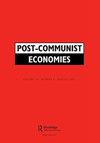货币和银行业的商业周期模型:保加利亚的案例(1999-2018)
IF 1.8
3区 经济学
Q2 ECONOMICS
引用次数: 0
摘要
摘要:我们用更丰富的政府部门来扩充原本标准的商业周期模型,并添加了修改后的预付现金(CIA)和存款考虑因素。特别是,早期工作中的预付现金和存款限制都扩大到包括私人投资和政府消费。此外,部分购买是使用信用卡进行的。货币发行局引入后(1999-2000年),该规范根据保加利亚的数据进行了校准,货币和昂贵的信贷在加剧经济波动中发挥了作用。特别是,修改后的中央情报局约束将货币理论与银行理论相结合,从而产生了一种新的机制,使该框架能够更好地再现模型变量之间观察到的可变性和相关性,尤其是劳动力市场的特征。本文章由计算机程序翻译,如有差异,请以英文原文为准。
A business-cycle model with money and banking: the case of Bulgaria (1999–2018)
ABSTRACT We augment an otherwise standard business cycle model with a richer government sector and add modified cash in advance (CIA) and deposit considerations. In particular, both the cash in advance- and deposit constraints of in earlier work are extended to include private investment and government consumption. Also, part of the purchases are made using credit. This specification is then calibrated to Bulgarian data after the introduction of the currency board (1999–2020), gives a role to money and costly credit in accentuating economic fluctuations. In particular, the modified CIA constraint combines monetary with banking theory, and thus produces a novel mechanism that allows the framework to reproduce better observed variability and correlations among model variables, and those characterising the labour market in particular.
求助全文
通过发布文献求助,成功后即可免费获取论文全文。
去求助
来源期刊

Post-Communist Economies
ECONOMICS-
CiteScore
4.90
自引率
18.20%
发文量
21
期刊介绍:
Post-Communist Economies publishes key research and policy articles in the analysis of post-communist economies. The basic transformation in the past two decades through stabilisation, liberalisation and privatisation has been completed in virtually all of the former communist countries, but despite the dramatic changes that have taken place, the post-communist economies still form a clearly identifiable group, distinguished by the impact of the years of communist rule. Post-communist economies still present distinctive problems that make them a particular focus of research.
 求助内容:
求助内容: 应助结果提醒方式:
应助结果提醒方式:


